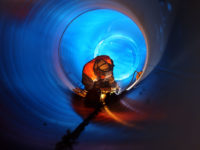Our eyes are among the most sensitive and vital parts of our bodies. They can be exposed to dust, chemicals, and other debris whenever they open, leading to irritation. Sharp objects can also penetrate the eye, leading to permanent vision loss.
Anyone working in an industrial environment where natural materials are cut, sanded, or ground, could easily injure their eyes due to the amount of particulate matter in the air. The same applies to those working with or near hazardous chemicals and sharp edges and points.
These incidents endanger workers, and can lead to costly delays and potential legal issues. The easiest way to prevent them is to wear safety eyewear with specific lenses or goggles for the job being done. According to the Bureau of Labor Statistics (BLS), wearing this personal protective equipment (PPE) can prevent 90% of all workplace eye injuries. When the BLS interviewed workers with eye injuries, three-fifths of the respondents weren’t wearing eye protection at the time of the incident and didn’t believe it was necessary.
Under ANSI Z87.1 from the American National Standards Institute, workers must have access to suitable eyewear that protects against impact, non-ionizing radiation, and liquid splash exposure. They also need training on why this PPE is required and how to maintain them over time.
Use this guide to select the proper eye protection equipment for the task at hand.
Choosing protective eyewear
Eyewear that complies with the ANSI Z87.1 mandate protects against low and high-velocity impacts, heat, chemicals, dust, and optical radiation, which provides a base layer of protection. These will work in many situations, but employers and workers should consider additional factors when choosing eyewear. Some jobs and hazards require special protective gear and features.
Lens coating and tint
Some pairs come with coatings that increase durability or visibility in certain situations, including:
- Anti-scratch coatings to protect against flying debris and sharp objects.
- Anti-fog coatings to prevent the glass from fogging over in cold temperatures.
- Anti-static coatings prevent particulate matter from sticking to the lens.
- Mirror coatings reduce glare when working outdoors.
- Coatings can be added separately or built into the eyewear.
- Tints refer to the color of the lenses. They can help increase visibility and protect against ultraviolet or infrared light to reduce eye strain.
- Clear lenses are suitable for normal working conditions.
- Gray lenses are suitable for indoor applications with partial sunlight.
- Amber and yellow lenses suit low-light conditions and provide added contrast.
- Light blue blocks glare from sodium vapor lighting often found in large warehouses.
- Dark green lenses offer non-welding protection from glare and UV rays.
- Photochromatic tints automatically adjust based on lighting conditions.
Most tints are built into the eyewear, but you can also use pairs with interchangeable tints when working in different settings.
Coatings and tints may be required when working with or near particular hazards. For example, specialized jobs like welding require special coatings and protections that the typical pair of safety glasses cannot provide.
Lens material
Consider the materials used to make the safety eyewear. Many are made of plastic or polycarbonate to keep them lightweight and durable. NXT Polyurethane, or Trivex, also offers excellent optical clarity compared to polycarbonate on its own, but can be quite costly. Others are made with acrylic, which is light and cheaper but less durable. Optical glass lenses were popular years ago and provided great scratch resistance and visibility, but are the heaviest, expensive and lacked significant impact resistance.
Fit, comfort, and style
Safety glasses only offer protection if they’re actually worn properly. The glasses should fit securely onto the person’s face and not fall off when they bend over or look down. Some pairs are one-size-fits-all, but everyone has a different face. Companies should provide pairs in different sizes to accommodate the crew. If the person can’t find eyewear that fits, the glasses may need to be adjusted by a professional. Ear straps and those that tie around the neck prevent goggles from falling to the floor, reducing the risk of damage. They also keep them within reach when workers take them on and off.
The eyewear must also work with other essential safety equipment, including hard hats, respirators, and face shields if this gear is needed on the job. No one should opt out of wearing goggles or other safety gear because they are uncomfortable to wear.
Prescription eyewear
Some workers may need special lenses or prescription eyewear to see on the job.
If the worker can get by without a prescription but has trouble seeing objects up close or far away, they can use bifocal safety goggles or a press-on lens that converts the pair to bifocals.
If the worker needs prescription eyewear, they can use a pair of goggles that fit over their prescription glasses or purchase prescription safety eyewear suited for their needs. Many optometrists and eyewear manufacturers provide this service. The worker or company should choose eyewear suitable for the application before the prescription lenses are made. It’s unsafe to wear contacts in areas with airborne hazards and debris — the particles could get trapped underneath the lens and cause irritation or damage to the eye.
Workers deserve to earn a living without damaging their eyes. Every eye incident delays work since the affected worker will need to rinse their eyes for up to 15 minutes or seek emergency medical attention. Training the staff on how and why they should use goggles is the best way to prevent these accidents.



